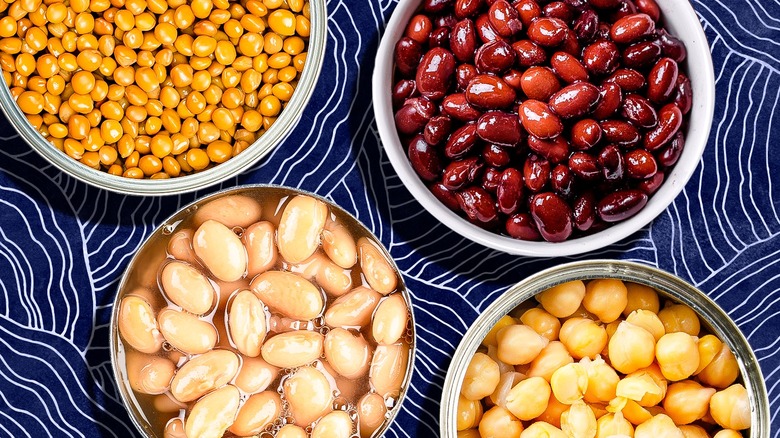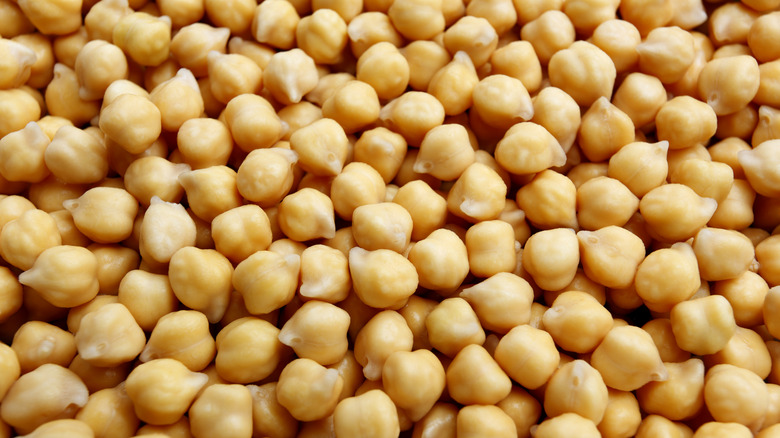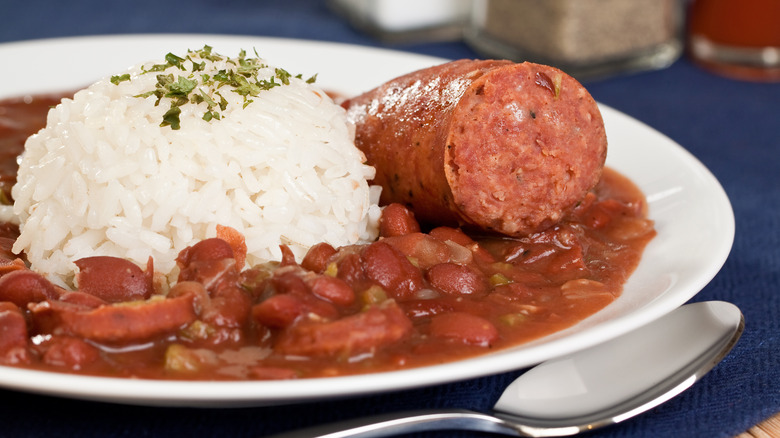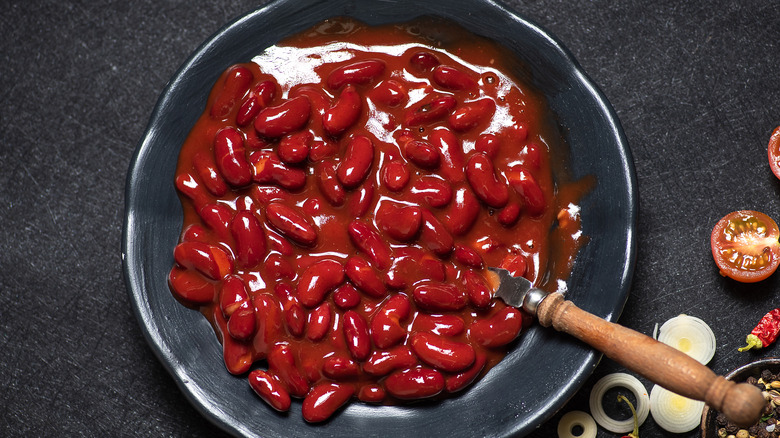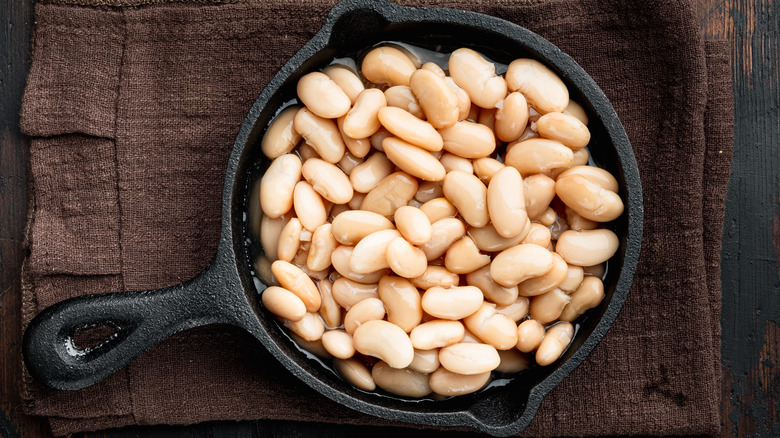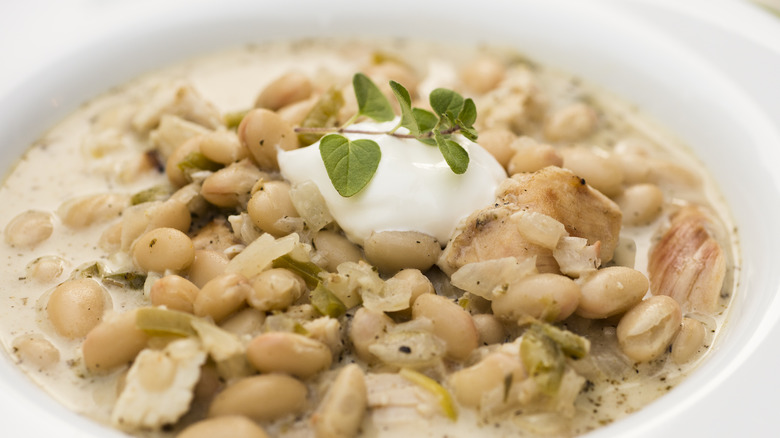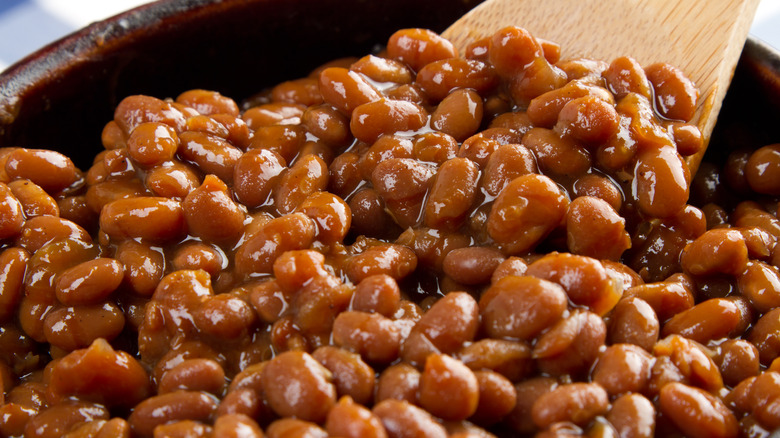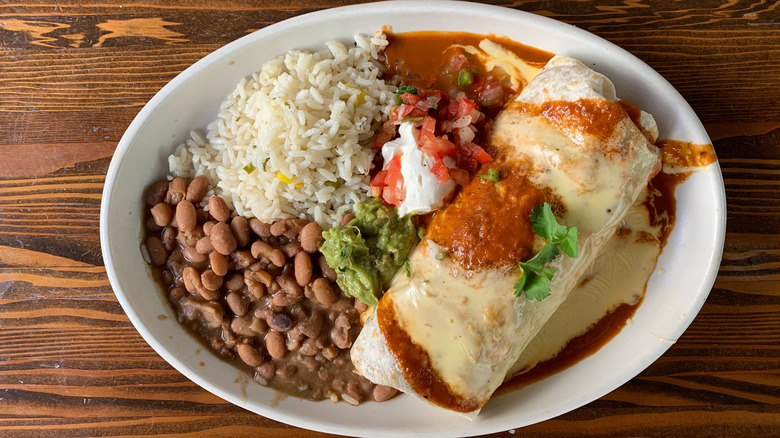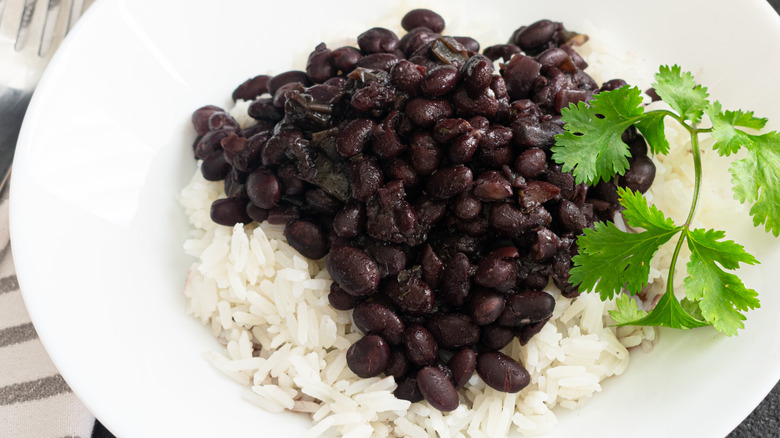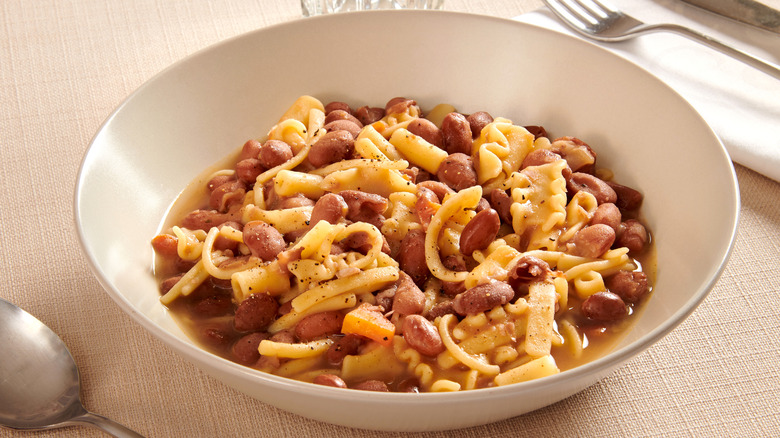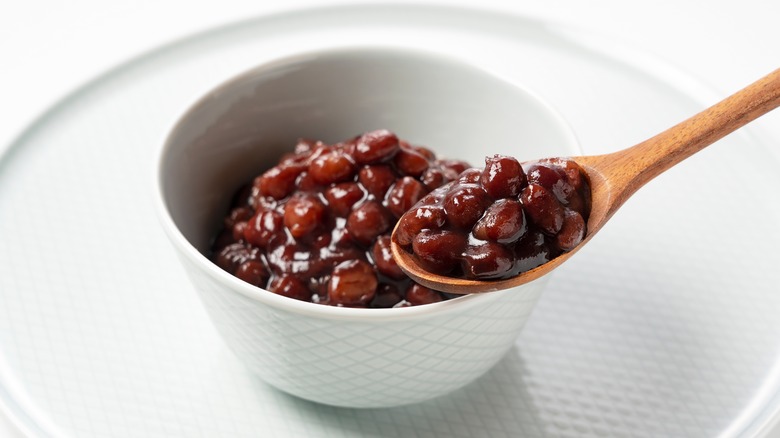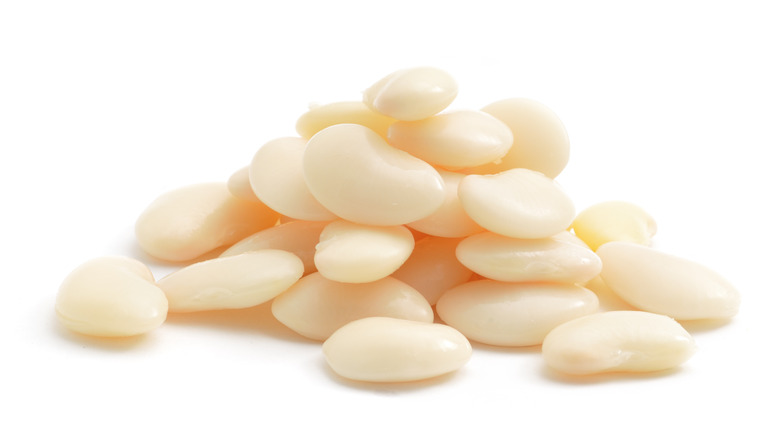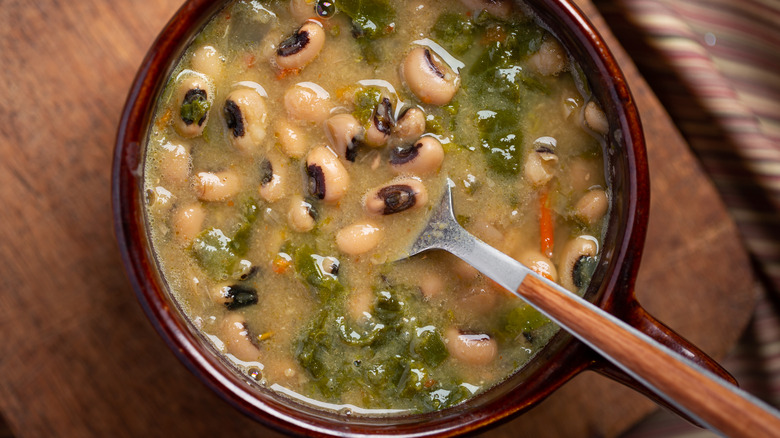12 Canned Beans You Should Keep In Your Pantry
Beans of all kinds have been a staple of human consumption for thousands of years across the globe. From adzuki beans to pinto beans, they're a cost-effective way to get more protein, fiber, and other nutrients in your diet. Plus, they're good for the planet as a relatively sustainable crop that benefits the soil by both sequestering carbon and fixing nitrogen deficiency. To recap: Beans are cheap, good for you, and good for the environment. Win, win, win!
A can of any kind of bean in your pantry can be a midweek meal lifesaver. Unlike dried beans, which can require soaking for at least eight hours before you even start cooking (unless you use a time-saving trick, that is), canned beans are ready to eat as soon as you pop them open. However, just because it's possible to eat them straight from the can doesn't mean you should. For the best flavor and texture, you really should rinse your canned beans before seasoning them with any variety of spices, herbs, vegetables, and/or meat you happen to have lying around. You can use just one variety, or create a combination of flavors, colors, and textures if you have multiple types of beans on hand.
Read on to find out about the best types of canned beans to keep in your pantry and the most delicious ways to cook with them.
Chickpeas
Chickpeas, also called garbanzo beans, are an exceedingly popular bean consumed across the world. There are two primary types: Kabuli and desi. Desi are smaller with thicker skin and are more common in India, while Kabuli are the larger, beige-colored variety you're more likely to come across in the United States. If you buy a can of chickpeas stateside, they're going to be Kabulis.
The classic use for chickpeas is, of course, hummus. You can easily make it yourself so long as you've got a blender or a food processor. All you have to do is combine a can of chickpeas, a few spoonfuls of tahini, a squeeze of fresh lemon, a drizzle of extra virgin olive oil, and a sprinkle of salt. But there are plenty of other ways to use chickpeas. You can add them to salads, soups, or stews, or roast them in the oven until they become crisp and crunchy.
Another great thing about canned chickpeas? The liquid they come in is useful, too, so think twice before pouring it down the drain. Known as aquafaba, chickpea water is a widely used vegan egg substitute. In fact, you should consider using aquafaba in cocktails that traditionally call for egg whites. Its proteins and carbohydrates create a similar type of foam when you shake it up.
Red beans
Red beans are the traditional ingredient used in Louisiana-style red beans and rice, and that is, in our opinion, the best way to use them. Smaller than kidney beans, red beans have a smooth rather than granular texture when cooked. Plus, their thin skins mean they take on a particularly creamy mouthfeel.
People in Louisiana and on the Gulf Coast typically eat red beans and rice on Mondays. That's because Monday was traditionally laundry day, which meant a whole lot of work before the advent of modern washing machines. The beans could simmer undisturbed for hours, usually with a ham bone from the previous day's roast, so that you had plenty of time to tend to the laundry. The tradition has stuck, and to this day, restaurants across the state serve red beans and rice on Mondays — whether the laundry is done or not.
When shopping for red beans, you'll typically have the choice between regular or cream-style red beans. Cream style doesn't mean cream has been added, but instead refers to the creamy texture of the beans inside the can. You can create cream-style beans with regular red beans, too: Simply crush some of them against the side of the pan as you heat them and stir. This technique actually works anytime you'd like to thicken up a pot of beans, no matter what kind you're using.
Kidney beans
Even though they look similar, kidney beans are larger than the red beans described here. They get their name due to their extraordinarily kidney-like shape and color. But don't worry, they don't taste anything like offal.
Kidney beans have a mild flavor, thickish dark-red skins, and a pale white interior. Those thick skins mean kidney beans hold their shape extremely well when cooked, so use them any time you'd like your beans to remain fully intact. For example, they're a great choice for a three-bean salad since they can handle being tossed around in the dressing without breaking apart. Kidney beans are also a solid ingredient to use in chili con carne, as they'll hold their shape even after stewing for hours with other ingredients.
But for one of the most delicious ways to enjoy kidney beans, look to Northern India and Pakistan, where this ingredient forms the basis for rajma masala ("rajma" is the word for kidney beans in this part of the world). All you have to do is simmer canned, drained, and rinsed kidney beans in a flavorful tomato sauce that's seasoned with garam masala, coriander, cumin, and other spices. You'll blend some of the beans into the sauce to create a thicker texture, and then serve with rice or Indian-style flatbread. If you've got an Instant Pot, try our recipe for Instant Pot rajma: Once the kidneys have been soaked overnight, the recipe itself comes together quickly and is extremely flavorful and nutritious.
Cannellini beans
Cannellini beans are an ivory-colored, medium-sized bean from Italy. They're especially popular in the central regions, like Tuscany, where they grow particularly well. Sometimes called white kidney beans because of their oblong shape, cannellini beans also keep their form well when cooked.
With a nutty taste and a creamy texture, cannellini beans are a great choice for salads and a solid pairing with bright, herbaceous, or citrusy dressings. To make a quick meal packed with protein, combine one can of rinsed and drained cannellini beans with one jar of tuna preserved in extra virgin olive oil, some quick pickled red onion, and some fresh parsley. You'll never reach for a protein shake again.
Naturally, the cannellini is the perfect bean for any number of Italian dishes, including minestrone, pasta e fagioli, or the Tuscan bean and tomato stew known as fagioli all'uccelletto. Thanks to their creamy interior texture, cannellini beans are also a good option for making white bean dip. For a quick appetizer, blend a can of rinsed and drained cannellini beans with a jar of artichoke hearts preserved in extra virgin olive oil and some parmesan cheese. Taste and adjust the acidity with a bit of lemon juice, and then serve with raw vegetables, bread, or crackers.
Great northern beans
Great northern beans are very similar to cannellini beans, and in a pinch, you can absolutely use them interchangeably. But to substitute them successfully, there are some key differences to keep in mind. Approximately the same size, great northern beans have a flatter shape with a lighter, more delicate texture. That softer consistency means they'll readily absorb the other flavors you pair them with. That's why great northerns are a solid choice for stews or any dish with a long cooking time. Like red beans, they can cream up very well — so if that's the texture you're after, they can be a good option.
While the origin of their name is unknown, it may come from the beans' large size and the fact that they're commonly grown in the upper Midwest. Regardless of origin, they work well in a white bean and ham stew. Simmered with a ham hock, great northern beans absorb the pork's smokey, salty flavor and break down into an irresistible texture. If you've got a few cans of great northern beans on hand, try our herby ham and bean soup recipe. Be sure to serve it alongside some fresh, crusty bread to sop up all the lovely juices.
Navy beans
Navy beans are the smallest but perhaps the mightiest of all white beans. With 15 grams of protein and around 19 grams of fiber per cup, they're one nutrient-dense bean. Navy beans have been a staple food of — you guessed it — the U.S. Navy since the 1800s. While some sailors may have a fond memory of them, we imagine others are prone to develop a strong aversion after eating them too many days at sea. Not to mention, since approximately 1903, dining areas in the U.S. Senate have served Senate bean soup. This simple preparation of ham, onions, navy beans, and butter has fed countless staffers for over 100 years.
Like cannellini beans, navy beans retain their shape well when cooked and have a slightly nutty taste. Their shape, flavor, availability, and texture mean navy beans are also the bean of choice for Boston baked beans. Slow-cooked in the oven with pork and molasses, the uppermost beans develop a savory crust, while those underneath remain creamy and soft.
Navy beans are well suited to plenty of other baked bean dishes, such as French cassoulet, but you can also buy navy beans pre-seasoned. The ubiquitous canned baked beans are in fact navy beans in a sweet, tomatoey sauce seasoned with herbs and spices. An essential component of a classic full English breakfast, you could also eat them with no more than a side of toast and feel equally British.
Pinto beans
Pintos are the most popular bean in the United States, and a classic bean used in Mexican and Southwestern cuisine. Like all beans, they're a great source of protein, but pinto beans in particular are a rich source of fiber. The word "pinto" means "colored" or "painted" and refers to the dappled coloring of the dried bean. But once cooked, pinto beans' coloration mellows to a uniform light brown-pinkish color.
You're likely to find pinto beans inside burritos or tacos, on top of tostadas or nachos, or simply as a side dish next to a tortilla or a sopapilla. They can appear stewed and whole or creamy and refried. Canned pinto beans are an especially good choice for any Mexican or Southwestern preparation. Flavor them with onion, garlic, chili, and oregano for a quick stew or side dish. The next day, you can reheat them in a heavy-bottomed pan, pressing them against the sides and bottom of the vessel to create creamy refried beans. Of course, canned refried pinto beans are great, as well, and you can add flavor to canned refried beans with a dollop of sour cream, a squeeze of lime juice, or any number of warming spices.
Black beans
Black beans are small to medium-sized beans sometimes called "turtle beans". They have dark-black skins, a creamy white interior, and an exceptionally meaty texture, which makes them a great vegetarian or vegan alternative to animal proteins. One excellent use for black beans is black bean burgers. You essentially combine a can or two of drained and rinsed black beans with some sautéed onions and peppers, whichever spices you choose, fresh breadcrumbs, and an egg. Some recipes include cheese, nuts, kale, carrots, or other ingredients to create different flavors and textures. Remember, black bean burgers are nothing like their meaty counterparts, nor are they meant to be. Bean burgers are in a satisfying, nutritious category of their own.
Used all over the world, black beans are especially appreciated in Latin America and India. Like pinto beans, black beans are particularly popular in Mexican and Southwestern cuisine: They make a delicious topping for nachos or tostadas, and you can use them for refried beans if you're looking for a creamy, spreadable texture. Black beans are also the bean of choice for Cuban-style beans and rice. Flavor a can of black beans with onions, green bell peppers, bay leaves, and garlic, and you're well on your way to making a delicious batch of Cuban black beans.
If you're looking for a way to sneak some nutrition into your baked goods, you can even try adding canned black beans to brownies or cakes. Your baked treats will never be the same!
Borlotti beans
Borlotti beans are a medium-sized, thin-skinned variety that's popular around the world. It's believed the beans are native to Colombia, where they're called cargamanto, but they're known as cranberry beans in the United States due to the cranberry-colored pattern on their exteriors when raw. Like pinto beans, their coloring dissipates to a uniform tone when cooked; and like cannellini beans, borlotti are a great choice for pretty much any Italian recipe. With their dense texture and thin skins, cooked borlotti beans create a delicious broth. This makes them a particularly good choice for pasta e fagioli, sausage and bean risotto, or other preparations for which the broth is especially important.
Borlotti beans are also commonly used in Turkish cuisine. Perhaps the best way to prepare them is in a dish called barbunya pilaki. Simmering the borlotti beans alongside onions, garlic, and veggies like potatoes and carrots in extra virgin olive oil, the meal is then garnished with plenty of fresh lemon slices, and it's usually enjoyed partially chilled or at room temperature. So, let that be your excuse to eat borlotti beans at any temp!
Adzuki beans
Adzuki beans are a small, dark-red bean with a creamy white interior commonly used in East Asian cuisine. They're especially popular in China, Japan, and Korea. But unlike other beans on this list, adzuki beans reign supreme in the dessert department. They have a mildly nutty, slightly sweet flavor that makes them particularly suited to sweets of all kinds. Ground until smooth and blended with sugar, red bean paste is known as anko in Japan, danpat in Korea, and dòushā in China. For an in-depth look, check out our article on how adzuki beans transform into the sweet paste that stars in mochi, mooncakes, ice cream, and other desserts.
That said, adzuki beans are great for savory preparations, as well. But keep in mind that their naturally sweet flavor will come through in whatever dish you're making, so be prepared to balance their flavor with other ingredients. While you can use adzuki beans as you would other beans in salads, soups, stews, and curries, blending them into a hummus-like dip for fresh vegetables or crackers also makes for a delicious snack.
Lima beans
Lima beans have a slightly flattened, half-moon shape and come in a variety of sizes depending on their maturity level. Smaller beans are less starchy and have a fresher flavor, whereas the larger ones are earthier and meatier. Lima beans are identical to butter beans, so the meaning of butter beans just depends on where you live. In the American South and the United Kingdom, everyone calls them butter beans, especially if they're fresh; but elsewhere, they're referred to as lima beans no matter their age.
Along with corn and squash, lima beans are one of the three sisters in Native American cuisine and a key ingredient in succotash. Lima beans can also be made into soups or stews, and like great northern beans, they tend to readily absorb the other flavors you prepare them with.
If you come across them, larger lima beans are particularly suited to pan-frying. Drain them from the can, rinse them in plenty of fresh water, and then dry them thoroughly yet gently with a clean dish towel. Heat some olive oil in a pan and add the lima beans, pressing down on each one to really flatten them and crisp up their edges. Flip them over so they get nice and crunchy brown on both sides. Sprinkled with flakey sea salt, crisped lima beans make a great healthy snack or a protein-rich alternative to croutons for salads or soups.
Black-eyed peas
Black-eyed peas are a variety of cowpeas, but they aren't technically peas at all. Like other beans, black-eyed peas are a member of the legume family. Small and oval-shaped, they get their name from the black spot on an otherwise pale-colored bean. Despite their size, black-eyed peas are dense and meaty with a strong earthy flavor that stands up well to intense seasonings like smoked pork.
Black-eyed peas are especially popular in the American South, where they are traditionally eaten on January 1 for luck, wealth, and prosperity. There are also some symbolic reasons that black-eyed peas are eaten on New Year's Day: First of all, they're said to resemble coins; and second, their heartiness represents resilience. Hoppin' John is the classic way to consume them, in which they're stewed with onions, pork, and other seasonings.
Like black beans, black-eyed peas' hearty nature means they also make excellent bean burgers. For a snack, you can also blend them into a fantastic bean dip with nothing more than extra virgin olive oil, salt, and a touch of apple cider vinegar.
